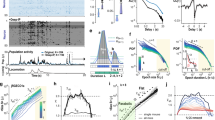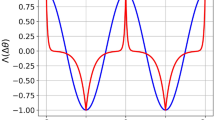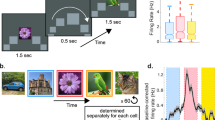Abstract
Neurons can produce action potentials with high temporal precision1. A fundamental issue is whether, and how, this capability is used in information processing. According to the ‘cell assembly’ hypothesis, transient synchrony of anatomically distributed groups of neurons underlies processing of both external sensory input and internal cognitive mechanisms2,3,4. Accordingly, neuron populations should be arranged into groups whose synchrony exceeds that predicted by common modulation by sensory input. Here we find that the spike times of hippocampal pyramidal cells can be predicted more accurately by using the spike times of simultaneously recorded neurons in addition to the animals location in space. This improvement remained when the spatial prediction was refined with a spatially dependent theta phase modulation5,6,7,8. The time window in which spike times are best predicted from simultaneous peer activity is 10–30 ms, suggesting that cell assemblies are synchronized at this timescale. Because this temporal window matches the membrane time constant of pyramidal neurons9, the period of the hippocampal gamma oscillation10 and the time window for synaptic plasticity11, we propose that cooperative activity at this timescale is optimal for information transmission and storage in cortical circuits.
This is a preview of subscription content, access via your institution
Access options
Subscribe to this journal
Receive 51 print issues and online access
$199.00 per year
only $3.90 per issue
Buy this article
- Purchase on Springer Link
- Instant access to full article PDF
Prices may be subject to local taxes which are calculated during checkout




Similar content being viewed by others
References
Mainen, Z. F. & Sejnowski, T. J. Reliability of spike timing in neocortical neurons. Science 268, 1503–1506 (1995)
Hebb, D. O. The Organization of Behavior (Wiley, New York, 1949)
Freiwald, W. A., Kreiter, A. K. & Singer, W. Synchronization and assembly formation in the visual cortex. Prog. Brain Res. 130, 111–140 (2001)
Engel, A. K., Fries, P. & Singer, W. Dynamic predictions: oscillations and synchrony in top-down processing. Nature Rev. Neurosci. 2, 704–716 (2001)
O'Keefe, J. & Recce, M. L. Phase relationship between hippocampal place units and the EEG theta rhythm. Hippocampus 3, 317–330 (1993)
Skaggs, W. E., McNaughton, B. L., Wilson, M. A. & Barnes, C. A. Theta phase precession in hippocampal neuronal populations and the compression of temporal sequences. Hippocampus 6, 149–172 (1996)
Harris, K. D. et al. Spike train dynamics predicts theta-related phase precession in hippocampal pyramidal cells. Nature 417, 738–741 (2002)
Mehta, M. R., Lee, A. K. & Wilson, M. A. Role of experience and oscillations in transforming a rate code into a temporal code. Nature 417, 741–746 (2002)
Spruston, N. & Johnston, D. Perforated patch-clamp analysis of the passive membrane properties of three classes of hippocampal neurons. J. Neurophysiol. 67, 508–529 (1992)
Csicsvari, J., Jamieson, B., Wise, K. D. & Buzsáki, G. Mechanisms of gamma oscillations in the hippocampus of the behaving rat. Neuron 37, 311–322 (2003)
Magee, J. C. & Johnston, D. A synaptically controlled, associative signal for Hebbian plasticity in hippocampal neurons. Science 275, 209–213 (1997)
Reinagel, P. & Reid, R. C. Precise firing events are conserved across neurons. J. Neurosci. 22, 6837–6841 (2002)
Kara, P., Reinagel, P. & Reid, R. C. Low response variability in simultaneously recorded retinal, thalamic, and cortical neurons. Neuron 27, 635–646 (2000)
Buracas, G. T., Zador, A. M., DeWeese, M. R. & Albright, T. D. Efficient discrimination of temporal patterns by motion-sensitive neurons in primate visual cortex. Neuron 20, 959–969 (1998)
Fenton, A. A. & Muller, R. U. Place cell discharge is extremely variable during individual passes of the rat through the firing field. Proc. Natl Acad. Sci. USA 95, 3182–3187 (1998)
Shadlen, M. N. & Newsome, W. T. Noise, neural codes and cortical organization. Curr. Opin. Neurobiol. 4, 569–579 (1994)
Lisman, J. E. & Idiart, M. A. Storage of 7 ± 2 short-term memories in oscillatory subcycles. Science 267, 1512–1515 (1995)
Redish, A. D. et al. Independence of firing correlates of anatomically proximate hippocampal pyramidal cells. J. Neurosci. 21, RC134 [online] 〈http://www.jneurosci.org/cgi/content/full/21/5/RC134〉 (2001)
Hirase, H., Leinekugel, X., Csicsvari, J., Czurko, A. & Buzsáki, G. Behavior-dependent states of the hippocampal network affect functional clustering of neurons. J. Neurosci. 21, RC145 [online] 〈http://www.jneurosci.org/cgi/content/full/21/10/RC145〉 (2001)
O'Keefe, J. & Nadel, L. The Hippocampus as a Cognitive Map (Clarendon, Oxford, 1978)
Wilson, M. A. & McNaughton, B. L. Dynamics of the hippocampal ensemble code for space. Science 261, 1055–1058 (1993)
Brown, E. N., Frank, L. M., Tang, D., Quirk, M. C. & Wilson, M. A. A statistical paradigm for neural spike train decoding applied to position prediction from ensemble firing patterns of rat hippocampal place cells. J. Neurosci. 18, 7411–7425 (1998)
Cox, D. R. & Isham, V. Point Processes (Chapman and Hall, London, 1980)
Csicsvari, J., Hirase, H., Czurko, A., Mamiya, A. & Buzsáki, G. Oscillatory coupling of hippocampal pyramidal cells and interneurons in the behaving rat. J. Neurosci. 19, 274–287 (1999)
Jensen, O. & Lisman, J. E. Position reconstruction from an ensemble of hippocampal place cells: contribution of theta phase coding. J. Neurophysiol. 83, 2602–2609 (2000)
deCharms, R. C. & Zador, A. Neural representation and the cortical code. Annu. Rev. Neurosci. 23, 613–647 (2000)
Wood, E. R., Dudchenko, P. A. & Eichenbaum, H. The global record of memory in hippocampal neuronal activity. Nature 397, 613–616 (1999)
Harris, K. D., Henze, D. A., Csicsvari, J., Hirase, H. & Buzsáki, G. Accuracy of tetrode spike separation as determined by simultaneous intracellular and extracellular measurements. J. Neurophysiol. 84, 401–414 (2000)
Quirk, M. C. & Wilson, M. A. Interaction between spike waveform classification and temporal sequence detection. J. Neurosci. Methods 94, 41–52 (1999)
Harris, K. D., Hirase, H., Leinekugel, X., Henze, D. A. & Buzsáki, G. Temporal interaction between single spikes and complex spike bursts in hippocampal pyramidal cells. Neuron 32, 141–149 (2001)
Acknowledgements
We thank J. E. Lisman, D. L. Buhl, S. M. Montgomery, P. E. Bartho and I. Creese for comments on the manuscript. This work was supported by grants from the National Institutes of Health
Author information
Authors and Affiliations
Corresponding author
Ethics declarations
Competing interests
The authors declare that they have no competing financial interests.
Supplementary information
Rights and permissions
About this article
Cite this article
Harris, K., Csicsvari, J., Hirase, H. et al. Organization of cell assemblies in the hippocampus. Nature 424, 552–556 (2003). https://doi.org/10.1038/nature01834
Received:
Accepted:
Issue Date:
DOI: https://doi.org/10.1038/nature01834
This article is cited by
-
The generative grammar of the brain: a critique of internally generated representations
Nature Reviews Neuroscience (2024)
-
Transparent neural interfaces: challenges and solutions of microengineered multimodal implants designed to measure intact neuronal populations using high-resolution electrophysiology and microscopy simultaneously
Microsystems & Nanoengineering (2023)
-
Design and fabrication of a microelectrode array for studying epileptiform discharges from rodents
Biomedical Microdevices (2023)
-
Biphasic Cholinergic Modulation of Reverberatory Activity in Neuronal Networks
Neuroscience Bulletin (2023)
-
Bayesian Coherence Analysis for Microcircuit Structure Learning
Neuroinformatics (2023)
Comments
By submitting a comment you agree to abide by our Terms and Community Guidelines. If you find something abusive or that does not comply with our terms or guidelines please flag it as inappropriate.



